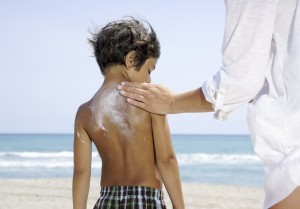When choosing a sunscreen for your kids health, the greatest urge may be to simply grab something off the shelf of your local drug store. There are a variety of sunscreens that are specifically marketed for children, but in reality the formulations of these sunscreens are not really that much different than the ones you find in regular formulas that are marketed for adults.
Harmful Ingredients
Unfortunately , there are a number of ingredients used in sunscreens that are known to be harmful to our health. Some of these ingredients can be even more dangerous to the developing bodies of children.
So, when shopping for a sunscreen for your children, what type should you buy? The most important thing to remember is that there are some ingredients that you need to avoid when shopping for sunscreens. Some of the most dangerous ones include the following:
- Parabens (butyl-,ethyl-,methyl-, and propyl-) are preservatives commonly used in sunscreens, so it may be a bit of a challenge to try avoiding them. Parabens are known to accumulate in the breast tissue of women with breast cancer and they have also produced abnormal hormonal effects within laboratory rodents.
- PABA causes a DNA defect in human cells, so it has been removed from most sunscreens. Make sure you read labels, however, to be sure that this ingredient is not listed in a product you buy. PABA is a dangerous chemical and it should always be avoided.
- Padimate-O and Parsol 1789 (Avobenzone) are chemicals designed to prevent UV damage, but they have actually been shown to cause DNA damage after being absorbed into the skin. Some evidence suggests that sunlight exposure is what actually causes the chemicals to react, resulting in free radical damage.
- Benzophenone (benzophenone-3), homosalate, and octy-methoxycinnamate (octinoxate) have been shown to produce estrogenic effects after being absorbed into the skin. They are also linked to allergies and cell damage. These have been so widely used that the Centers for Disease Control estimates that about 97% of people in the United States are contaminated with these chemicals.
Which Ingredients should you look for?
The fact of the matter is that you should actively avoid most of the sunscreens that are sold in drug and discount stores. Titanium dioxide and zinc oxide are the two safest choices when checking out sunscreen ingredients because they reflect the sun’s rays off of your skin rather than absorbing them. There is also a lesser risk of these particular ingredients building up inside the body, which of course makes them safer for long-term use.
It is important to choose a sunscreen with a SPF of at least 15, but it is really not necessary to choose a product with one higher than about 30. You should also be prepared to reapply your child’s sunscreen every hour or so, particularly if he or she is going to be out in the sun for an extended period of time. You should reapply the sunscreen regularly, even if a sunscreen claims to be waterproof.
If you are concerned about the overall safety of sunscreens, you should take the time to research specific products and/or ingredients before making any purchases. There are some websites that offer analyses of products and ingredients in an effort to alert consumers to those products that many experts consider to be dangerous.
However, if you look for products that contain titanium dioxide and zinc oxide you should be able to feel confident that you have chosen the safest possible product for your child’s health and sun safety. Unfortunately, there are a number of ingredients used in sunscreens that are known to be harmful to our health. Some of these ingredients can be even more dangerous to the developing bodies of children.
By Andrew Van Vooren
Sources Used
1. Treadwell, Patricia. “What kind of sunscreen is best for children?” BabyCenter.com. http://www.babycenter.com/404_what-kind-of-sunscreen-is-best-for-children_
70547.bc. Accessed 21 September 2009.
2. “Safe Sunscreens for the Family.” NatureMoms.com. http://www.naturemoms.com/blog/
2008/04/21/safe-sunscreens/. Accessed 21 September 2009.
